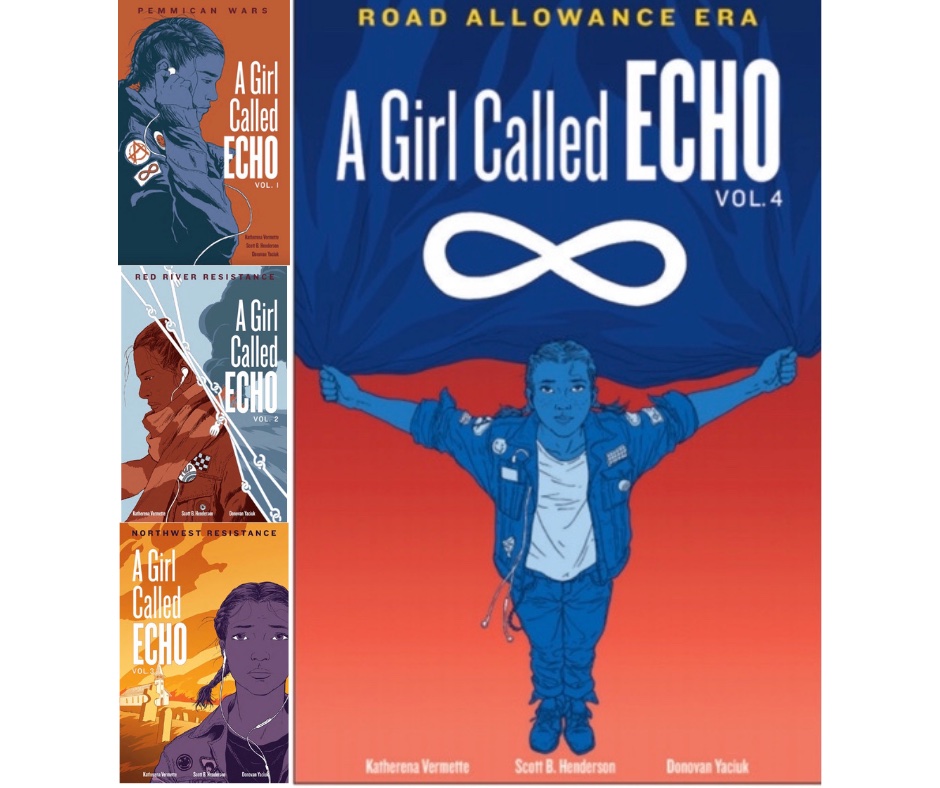By Gail Picco (May 10, 2021)
Road Allowance Era: Vol. 4, A Girl Called Echo, Katherena Vermette, Illustrated by Scott B. Henderson, Colour by Donovan Yaciuk, HighWater Press, Graphic Novel, Grades 5–9, April 27, 2021, 48 pp., $19.95

Road Allowance Era, a powerful conclusion to The Girl called Echo series of four graphic novels written for Highwater Press by Canadian novelist and Métis writer Katherena Vermette, is a singular accomplishment that combines vivid Métis history with what it’s like growing up as a Métis teenager in Canada today.
Echo Desjardins is a normal 13-year-old in many ways. She’s got her hoodie up, her jeans are baggy and her earphones in her ears constantly as she listens to Rage Against the Machine, Pearl Jam and Alice in Chains. When the A Girl Called Echo series opened up with book one, Pemican Wars, published in 2017, we find Echo living with her auntie while her mother seeks treatment for an undisclosed condition. She is about to attend a new school. But Echo has a special power. She’s a time traveller. And, as she sits in Mr. Bee’s history class, the finds herself transported to the Métis communities taking part in the battles for their land and through the political rise of and eventual execution of Louis Riel.
The North West Company, headquartered in Montreal had, in 1809, built Fort Gibraltar where the Red and Assiniboine rivers meet to establish their dominance over the Hudson’s Bay Company in the region. Pemmican Wars begins in 1814 when the governor “issues the Pemmican Proclamation, forbidding the export of pemmican and other provisions outside of Assiniboia for a year. He wants to ensure there are enough supplies to feed the settlers; however, the proclamation threatens the survival of local Métis, Indigenous, and European freemen families, who make their living selling pemmican and other supplies to the NWC.”
Her first interaction with a 19th century counterpart who is wearing a dress with an apron and carrying water buckets in each hand, Echo is wearing cargo pants and a tee-shirt with the word WEIRD etched.
“You look lost …” the girl holding the buckets says to a startled Echo. And our journey begins …
This last book in the series Road Allowance Era covers the time from 1870, when “The Manitoba Act is passed, establishing the new province, and granting 1.4 million acres of land to the Métis, as well as title to the land already farmed (approximately 2.5 million acres in all), but through a series of amendments requiring those applying for land to prove “undisturbed occupancy,” many Métis lost their land patents as well as the right of appeal, eventually occupying areas that had been set aside for roads (road allowance) or on Crown land with no land rights.
It was the time of the leadership of Louis Riel, a founder of Manitoba and central figure in the Red River and North-West resistances (the subjects of books 2 and 3 of the series) and Road Allowance Era covers Riel’s execution for high treason for his role in the 1885 resistance to Canadian encroachment on Métis lands. He was the first and only person in Canadian history ever executed for treason.
Road Allowance Era, like the other three books in the series, is assisted by illustrator Scott Henderson, the author/illustrator of The Chronicles of Era and colourist Donovan Yaciuk, whose has done work for Marvel, DC and Dark Horse Comics. It’s a great team. The panels of buffalo hunts on the prairie land to re-enacted battles are panoramic in their scope providing the sense of wide-open spaces, at times lush with nature, blood-red battlefields, and brilliant starry skies. The colours and illustrations in Echo’s 21st century life are more muted, cramped.
Road Allowance Era, like the entire A Girl Called Echo series, is based on Vermette’s research of the time. At the back of each book, we’re offered the historical timeline for the events depicted in the graphic novel. The series is written for a Grade 5 to 9 audience but like so much Young Adult fiction being published now, the appeal is broad, especially if the reader is like most Canadians and has never been exposed to Métis or Indigenous history of any kind.
“I know that, because of you, our people will survive,” an elderly 19th century woman tells Echo in the closing pages of Road Allowance, “because you have survived, and you are strong and well, and you will do many great things.”
(Gail Picco is editor in chief of The Charity Report.)
Other reviews by Gail Picco
David Love: Thoughts of an Environmental Fundraiser April 30, 2021
What Bears Teach Us: The push and pull of co-existence December 8, 2020
Begin Again by Eddie Glaude: James Baldwin as a Man for our Time November 30, 2020
She Proclaims: The necessity of women persistently proclaiming October 20, 2020
The reputation of philanthropy: A history of the facts September 18, 2020